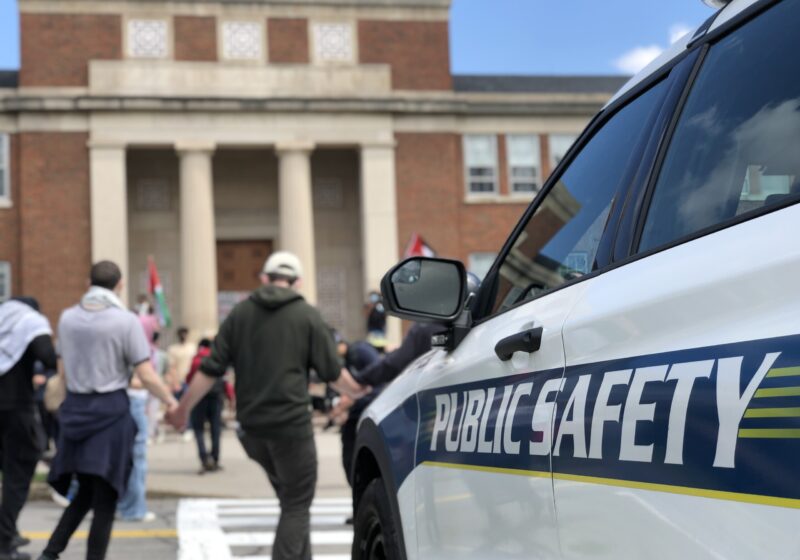The Eastman Wind Ensemble’s concert, performed in the Eastman Theatre on Friday, Jan. 23, featured only music from living composers, including visiting composer Don Freund. Conductor Mark Scatterday’s first program selection was “Fanfare for the Uncommon Woman No. 2,” by Joan Tower. Tower’s series of fanfares are inspired by Copland’s “Fanfare for the Common Man” and are dedicated to adventurous career women. The piece performed in this concert was written in 1989 and is dedicated to Joan Briccetti, former general manager of the St. Louis symphony orchestra. This short piece is scored for brass chamber ensemble and five percussionists. It avoids the overused wind instrument harmonies based on open fifths and its form constitutes a gradual build-up to the end. Extremely skillful in regard to orchestration, the “Fanfare” implies a much bigger ensemble then the one actually performing. It was the perfect selection for a wind ensemble concert opening. A graduate of Berklee School of Music and New England Conservatory, Danish composer Nicholas C. K. Thorne wrote his “Adagio Music op. 12” in 1980. The work is based on cluster-like chords which gradually spread out to open position triadic harmonies. The piece is unified mostly by an ostinato sigh-motive in the high register. Its affect on the audience depends very much on the dynamics and articulation of the performers, because the harmonic motion of the “Adagio” is very slow. Because the sigh motive is the only fully-developed idea, the work is a little too long. The composer does not juxtapose any of the other melodic ideas to it and the slow harmonic development is not sufficient to make up for the lack of melodic contrast. However, the piece leaves a positive impression on the listener, as it is tastefully composed, avoiding typical instrumental clichs. The title of John Corigliano’s suite, “Gazebo dances,” is a reference to the bandstands found in town squares in America. Corigliano said that his suite is formed by “the sense of summer joy and exuberance.” He described the first movement as “a modern Rossini-like movement,” the second one as a “peg legged waltz in which the oom-pah-pah sometimes lacks a pah” and the fourth movement as alternating “moments of great pseudo-seriousness with bouncing spirit.” Though very tonal, the Overture was definitely not Rossini, as the phrase rhythms differed throughout the piece. This movement, as well as the second and fourth movements, were charming and funny, getting a straight musical idea across. Scatterday’s interpretation was based on the classical tradition of articulation, straight-tone and phrasing, which did wonderful justice to the music. The second half of the concert was dedicated to Freund’s music. The wind ensemble performed two of his “Poem symphonies,” written in 1990. Each of these five minute-long pieces is inspired by a work of a contemporary American poet. The two pieces on the program were “End of summer” and “Radical light.” Their creation was motivated by poems by Stanely Kunitz and S. R. Ammons, respectively. “End of summer” is a non-dramatic and very sectionalized work. It consists of solo melodies, featuring different instruments accompanied by sustained harmonies. The atmosphere reminded the listener of Thorne’s “Adagio,” performed during the first half of the concert. “Radical light” is based on the gradual expansion of a long, single-line phrase. The main and only idea of this miniature is a triadic arpeggiation over the span of the entire register of the ensemble, which includes a prominent piano part. Scatterday took a very cautious tempo to ensure that the main line is passed promptly from instrument to instrument, and thus the main feature of the piece was lost in this performance. This performance of the piece lasted eight minutes instead of the five that the composer indicated, and the trading of the line between the players still did not work every time. The concert closed with “Jug Blues and Fat Pickin’,” composed in 1986. This work was inspired by the bluegrass banjo, which becomes “flattened out” by the sounds of winds. The composer’s instruction for the “Blues” are “wail, like a giant harmonica,” in contrast to the “Pickin'” “with easy virtuosity.” The “Pickin’,” is a series of strict harmonic variations in jazz style over a steady B-flat major ostinato. This easy-going and enjoyable work closed the concert. The close collaboration between the conductor and the ensemble showed in the high level of preparation. The performers demonstrated a good understanding of the diverse contemporary styles featured during the concert. With the exception of “Radical light,” the program was performed with high ensemble virtuosity and punctuality. Scatterday’s adventurous programming during this semester’s concert season in Eastman will continue with the Jan. 28th Eastman Wind Ensemble concert. He and Cindi Johnston Turner will conduct works by Finney, Makris, Milhaud and Nelson. Fol can be reached at afol@campustimes.org.
Administration
Recording shows University statement inaccurate about Gaza encampment meeting
The Campus Times obtained a recording of the April 24 meeting between Gaza solidarity encampment protesters and administrators. A look inside the discussions.
data
The NBA’s MVP candidates
Against the Cleveland Cavaliers, center Nikola Jokić posted 26 points, 18 rebounds, and 16 assists in 35 minutes. That same…
Gaza Solidarity Encampment
Live updates: Wallis Hall sit-ins
Editor’s Note (5/4/24): This article is no longer being updated. For our most up to date coverage, look for articles…

